Discover 35 hidden attractions, cool sights, and unusual things to do in Isfahan (Iran). Don't miss out on these must-see attractions: Chehel Sotoun, Jameh Mosque of Isfahan, and Ālī Qāpū. Also, be sure to include Naqsh-e Jahan Square in your itinerary.
Below, you can find the list of the most amazing places you should visit in Isfahan (Esfahan).
Table of Contents
Chehel Sotoun
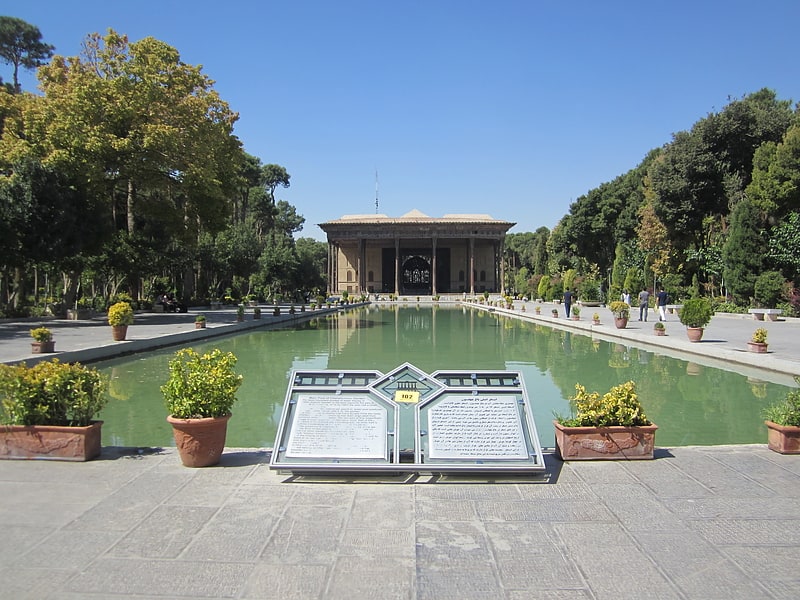
Also known as: چهلستون
Elegant, 17th-c. royal pavilion and garden. Chehel Sotoun is a Persian pavilion in the middle of a park at the far end of a long pool, in Isfahan, Iran, built by Shah Abbas II to be used for his entertainment and receptions. In this palace, Shah Abbas II and his successors would receive dignitaries and ambassadors, either on the terrace or in one of the stately reception halls.
The name, meaning "Forty Columns" in Persian, was inspired by the twenty slender wooden columns supporting the entrance pavilion, which, when reflected in the waters of the fountain, is said to appear to be forty.
As with Ali Qapu, the palace contains many frescoes and paintings on ceramic. Many of the ceramic panels have been dispersed and are now in the possession of major museums in the west. They depict specific historical scenes such as the infamous Battle of Chaldiran against the Ottoman Sultan Selim I, the reception of an Uzbek King in 1646, when the palace had just been completed; the welcome extended to the Mughal Emperor, Humayun who took refuge in Iran in 1544; the battle of Taher-Abad in 1510 where the Safavid Shah Ismail I vanquished and killed the Uzbek King. A more recent painting depicts Nader Shah's victory against the Indian Army at Karnal in 1739. There are also less historical, but even more aesthetic compositions in the traditional miniature style which celebrate the joy of life and love.
The Chehel Sotoun Palace is among the 9 Iranian Gardens which are collectively registered as one of the Iran’s 23 registered World Heritage Sites under the name of the Persian Garden.[1]
Address: Imam Hossein Square, Isfahan
Jameh Mosque of Isfahan
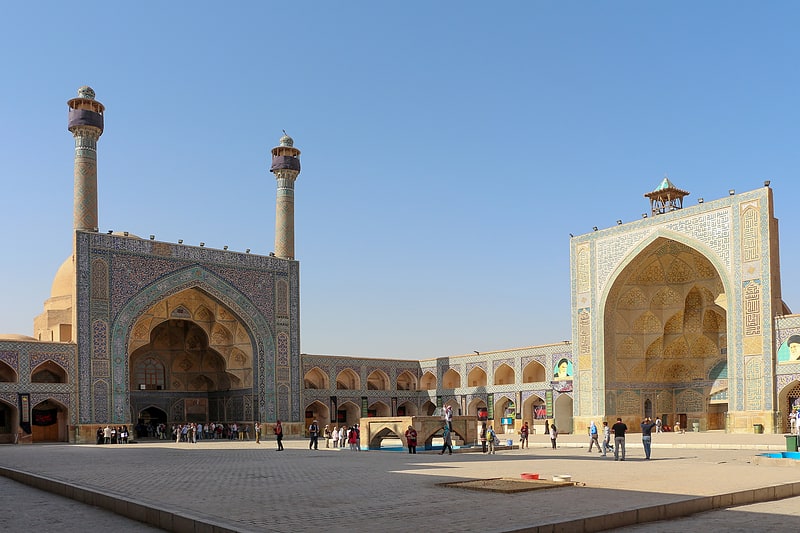
Also known as: مسجد جامع اصفهان
Mosque known for its varied architecture. The Jāmeh Mosque of Isfahān or Jāme' Mosque of Isfahān, also known as the Atiq Mosque and the Friday Mosque of Isfahān, is a historic congregational mosque of Isfahan, Iran. The mosque is the result of continual construction, reconstruction, additions and renovations on the site from around 771 to the end of the 20th century. The Grand Bazaar of Isfahan can be found towards the southwest wing of the mosque. It has been a UNESCO World Heritage Site since 2012. It is one of the largest and most important monuments of Islamic architecture in Iran.[2]
Address: Esfahan Bazaar, 81464 Isfahan
Ālī Qāpū
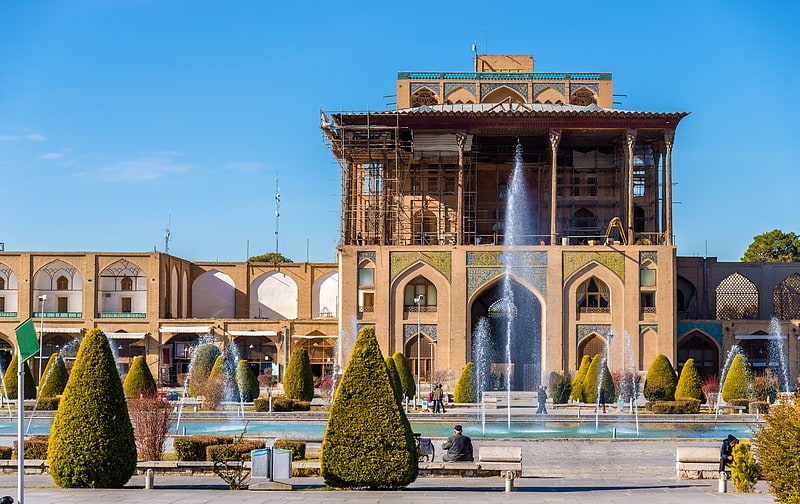
Also known as: عالیقاپو
Majestic palace with a lavish music room. Ali Qapu Palace or the Grand Ālī Qāpū is an imperial palace in Isfahan, Iran. It is located on the western side of the Naqsh-e Jahan Square, opposite to Sheikh Lotfollah Mosque, and had been originally designed as a vast portal entrance to the grand palace which stretched from the Naqsh-e Jahan Square to the Chahar Baq Boulevard. The palace served as the official residence of Persian Emperors of the Safavid dynasty. UNESCO inscribed the Palace and the Square as a World Heritage Site due to its cultural and historical importance. The palace is forty-eight meters high and there are six floors, each accessible by a difficult spiral staircase. In the sixth floor, Music Hall, deep circular niches are found in the walls, having not only aesthetic value, but also acoustic. Ālī Qāpū is regarded as the best example of Safavid architecture and a symbol of Iran's Islamic heritage.
The name Ali Qapu, from Persian ‘Ālī (meaning "imperial" or "great"), and Azerbaijani Qāpū (meaning "gate"), was given to this place as it was right at the entrance to the Safavid palaces which stretched from the Naqsh-e Jahan Square to the Chahar Baq Boulevard. The building, another wonderful Safavid edifice, was built by decree of Shah Abbas I in the early seventeenth century. It was here that the great monarch used to entertain noble visitors, and foreign ambassadors. Shah Abbas, here for the first time, celebrated the Nowruz (Iranian New Year) of 1006 AH / 1597 C.E.
Ali Qapu is rich in naturalistic wall paintings by Reza Abbasi, the court painter of Shah Abbas I, and his pupils. There are floral, animal, and bird motifs in his works. The highly ornamented doors and windows of the palace have almost all been pillaged at times of social anarchy. Only one window on the third floor has escaped the ravages of time. Ali Qapu was repaired and restored substantially during the reign of Shah Sultan Hussein, the last Safavid ruler, but fell into a dreadful state of dilapidation again during the short reign of invading Afghans. Under the reign of Naser ad-Din Shah the Qajar (1848–96), the Safavid cornices and floral tiles above the portal were replaced by tiles bearing inscriptions.
Shah Abbas II was enthusiastic about the embellishment and perfection of Ali Qapu. His chief contribution was given to the magnificent hall, the constructors on the third floor. The 18 columns of the hall are covered with mirrors and its ceiling is decorated with great paintings.
The chancellery was stationed on the first floor. On the sixth, the royal reception and banquets were held. The largest rooms are found on this floor. The stucco decoration of the banquet hall abounds in motif of various vessels and cups. The sixth floor was popularly called the Music Hall. Here various ensembles performed music and sang songs.
From the upper galleries, the Safavid ruler watched Chowgan (polo), army maneuvers and horse-racing in the Naqsh-e Jahan square.
The palace is depicted on the reverse of the Iranian 20,000 rials banknote. The palace is also depicted on the reverse of the Iranian 20 rials 1953 banknote series.[3]
Address: Naghshe Jahan Sq,Sepah St, Imam Hossein Square, 4 Bagh St, Isfahan, Iran, 81464 Isfahan
Naqsh-e Jahan Square
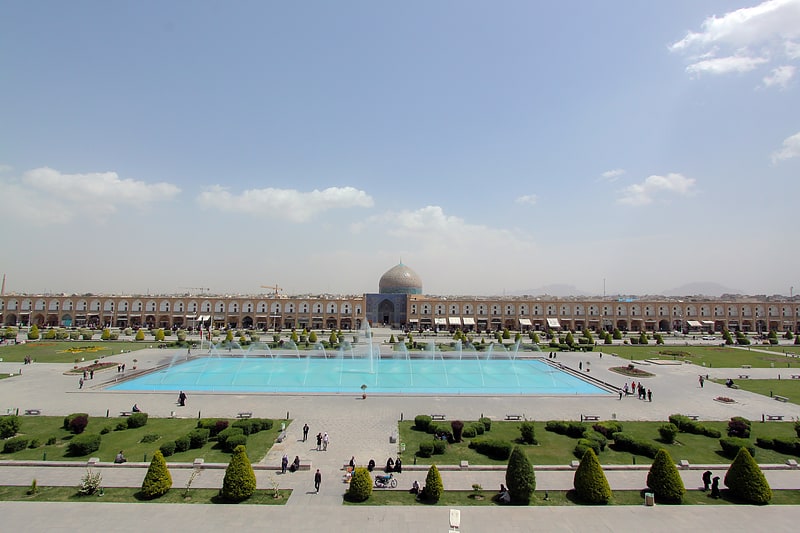
Also known as: میدان نقش جهان
Historic square constructed in 1598. Naqsh-e Jahan Square officially Midan Imam Khomeini, also known as the Shah Square prior to 1979, is a square situated at the center of Isfahan, Iran. Constructed between 1598 and 1629, it is now an important historical site, and one of UNESCO's World Heritage Sites. It is 160 metres wide by 560 metres long. It is also referred to as Shah Square or Imam Square. The square is surrounded by buildings from the Safavid era. The Shah Mosque is situated on the south side of this square. On the west side is the Ali Qapu Palace. Sheikh Lotf Allah Mosque is situated on the eastern side of this square and at the northern side Qeysarie Gate opens into the Isfahan Grand Bazaar. Today, Namaaz-e Jom'eh is held in the Shah Mosque.
The square is depicted on the reverse of the Iranian 20,000 rials banknote.[4]
Address: Naghsh-e Jahan Sq., Isfahan
Shah Mosque
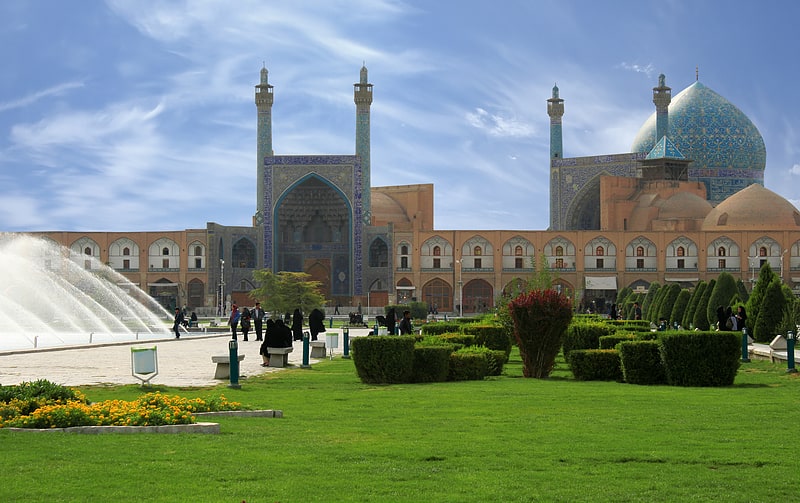
Also known as: مسجد شاه
Mosque in Isfahan, Iran. The Shah Mosque is a mosque located in Isfahan, Iran. It is located on the south side of Naghsh-e Jahan Square. It was built during the Safavid dynasty under the order of Shah Abbas I of Persia.
It is regarded as one of the masterpieces of Persian architecture in the Islamic era. The Royal Mosque is registered, along with the Naghsh-e Jahan Square, as a UNESCO World Heritage Site. Its construction began in 1611, and its splendour is mainly due to the beauty of its seven-colour mosaic tiles and calligraphic inscriptions.
The mosque is depicted on the reverse of the Iranian 20,000 rials banknote.[5]
Address: Naghsh-e Jahan Sq., Isfahan
Sheikh Lotfollah Mosque
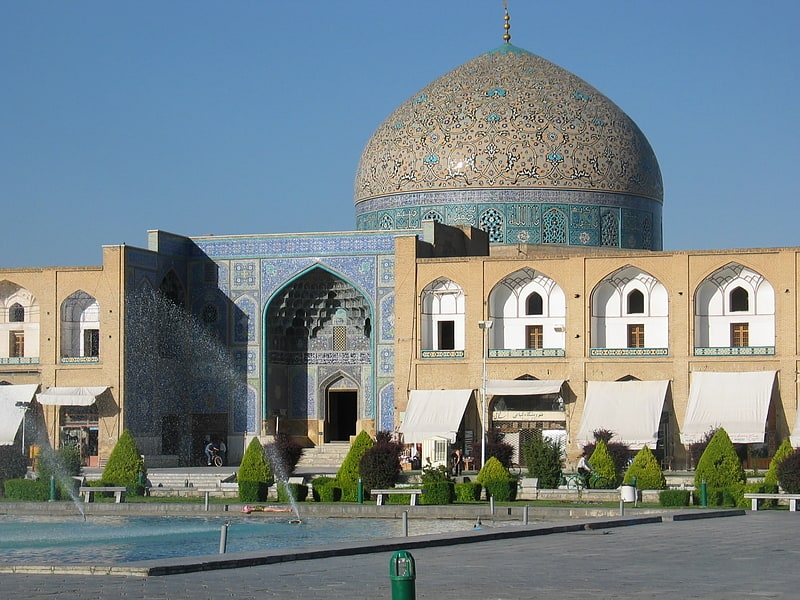
Also known as: مسجد شیخ لطفالله
Mosque in Isfahan, Iran. Sheikh Lotfollah Mosque is one of the masterpieces of Iranian architecture that was built during the Safavid Empire, standing on the eastern side of Naqsh-i Jahan Square, Esfahan, Iran. Construction of the mosque started in 1603 and was finished in 1619. It was built by the chief architect Mohammadreza Isfahani, during the reign of Shah Abbas I of Persia. On the advice of Arthur Upham Pope, Reza Shah Pahlavi had the mosque rebuilt and repaired in the 1920s.[6]
Address: Naghshe-E Jahan Square, Sepah St, Imam Hossein Square, 4 Bagh St, Isfahan, Iran, 81464 Isfahan
Khaju Bridge

Also known as: پل خواجو
Picturesque 17th-century bridge. The Khaju Bridge is one of the historical bridges on the Zayanderud, the largest river of the Iranian Plateau, in Isfahan, Iran. Serving as both a bridge and a weir, it links the Khaju quarter on the north bank with the Zoroastrian quarter across the Zayanderud. It is located at the end of Kamal Ismail Street in Isfahan.
The bridge served a primary function as a building and a place for public meetings in the past. It has been described as the city's finest bridge.
Persian art historians and revivalists, Arthur Upham Pope and Phyllis Ackerman are interred in a mausoleum nearby.[7]
Address: Khaju St., Isfahan
Hasht Behesht
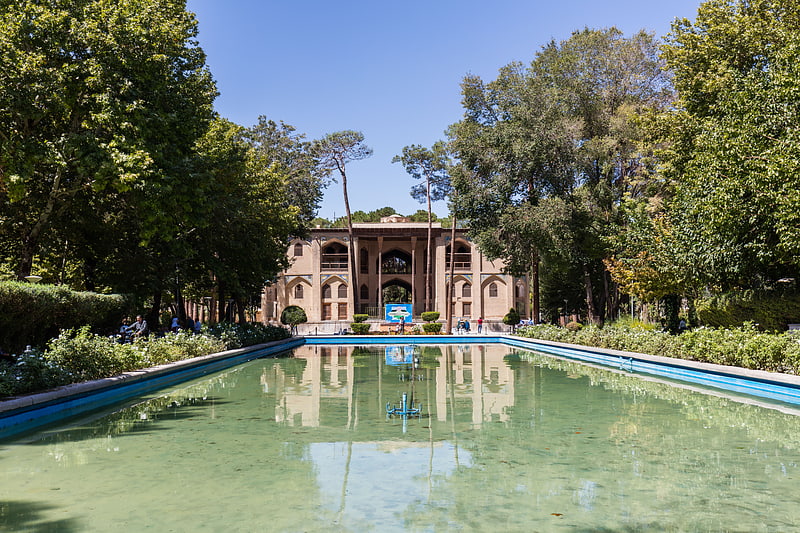
Also known as: کاخ هشتبهشت
Enduring royal palace built in 1669. Hasht Behesht, literally meaning "the Eight Heavens" in Persian, is a 17th-century pavilion in Isfahan, Iran. It was built by order of Suleiman I, the eighth shah of Iran's Safavid Empire, and functioned mainly as a private pavilion. It is located in Isfahan's famous Charbagh Street. It was also the first modern school in Isfahan was called His Majesty's School.[8]
Address: 4bagh E Abbasi Street, 81464 Isfahan
Si-o-se-pol
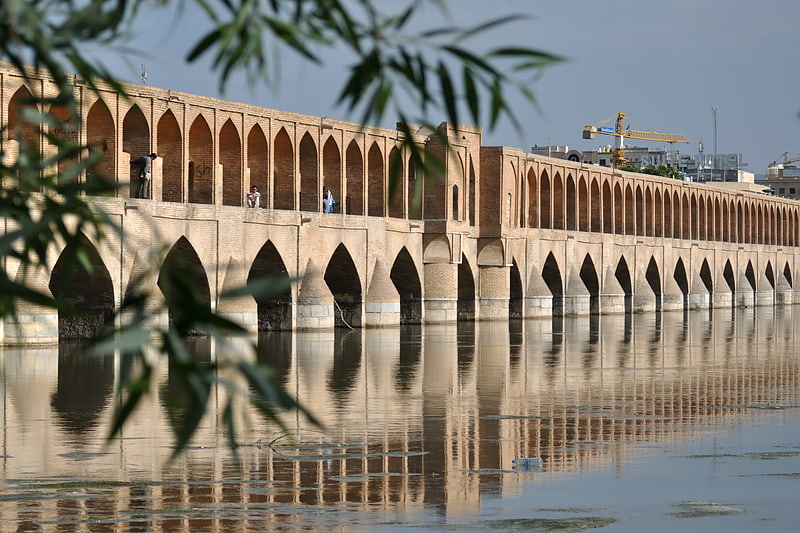
Also known as: سیوسهپل
Iconic stone bridge with 33 arches. The Allahverdi Khan Bridge, popularly known as Si-o-se-pol, is the largest of the eleven historical bridges on the Zayanderud, the largest river of the Iranian Plateau, in Isfahan, Iran.
The bridge was built in the early 17th century to serve as both a bridge and a dam. It is a popular recreational gathering place, and is one of the most famous examples of Iran's Safavid architecture.[9]
Address: Chaharbagh St., Isfahan
Vank Cathedral
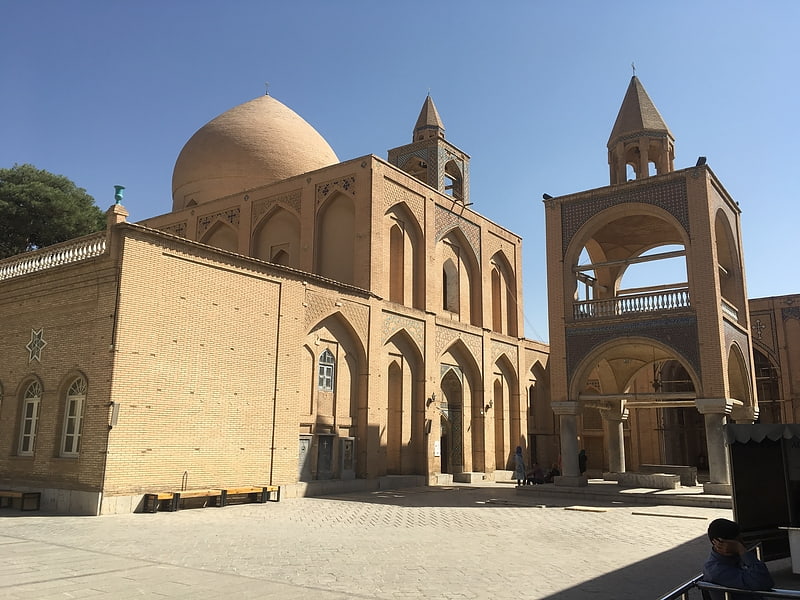
Also known as: کلیسای وانک
17th-century church with bright frescoes. The Holy Savior Cathedral, also known the Church of the Saintly Sisters, is a cathedral located in the New Julfa district of Isfahan, Iran. It is commonly referred to as the Vank, which means "monastery" or "convent" in the Armenian language.[10]
Address: Vank Church Alley, 97953-81738 Isfahan
Birds Garden

Also known as: باغ پرندگان اصفهان
Bird watching area in Isfahan, Iran. The Bird Garden of Isfahan was founded in 1998 by the municipality of Isfahan and it is now under the supervision of the recreation and welfare organization of the municipality. The garden has an area of 17000 m². It's enclosed and covered by a chain-link fence pitched on 16 moveable metal pillars with a height of up to 32 m. More than 5000 birds from 130 different species are kept in the garden. The birds are native to different parts of Iran and also other countries like Australia, Indonesia, China, and Tanzania.[11]
Address: Olfat Street - Sohrevardi Square, 81464 Isfahan
Fire Temple of Isfahan
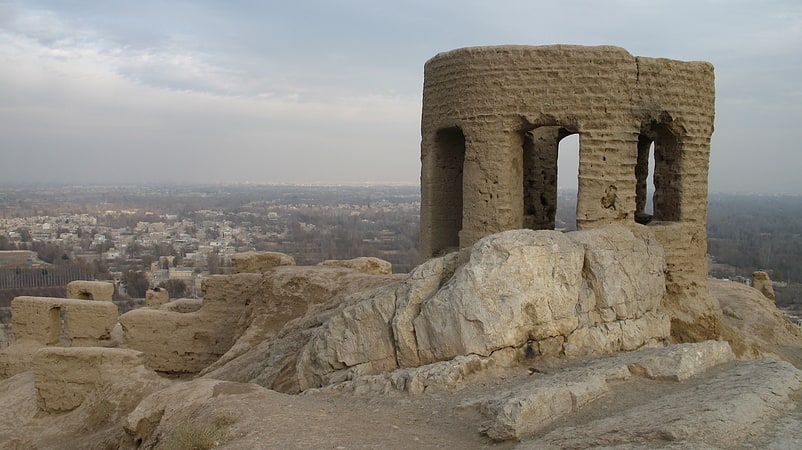
Also known as: آتشگاه اصفهان
Historical landmark in Isfahan, Iran. The Fire Temple of Isfahan is a Sassanid-era archaeological complex located on a hill of the same name about eight kilometers west of city center of Isfahan, Iran.
The hill, which rises about 210 meters above the surrounding plain, was previously called Maras or Marabin after a village near there, and it is by that name that the site is referred to by Arab historians.[12]
Natural History Museum of Isfahan
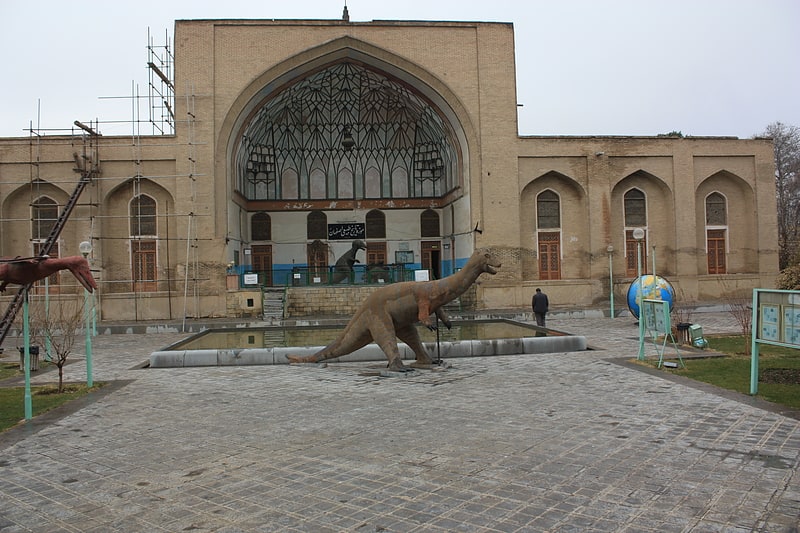
Also known as: موزه تاریخ طبیعی
Museum in Isfahan, Iran. The Natural History Museum of Isfahan, Iran, is located in a building that dates from the 15th century Timurid era. The building includes large halls and a veranda which are decorated by muqarnas and stucco. This building became a museum in 1988.[13]
Address: Ostandari Street, Isfahan
Monar Jonban
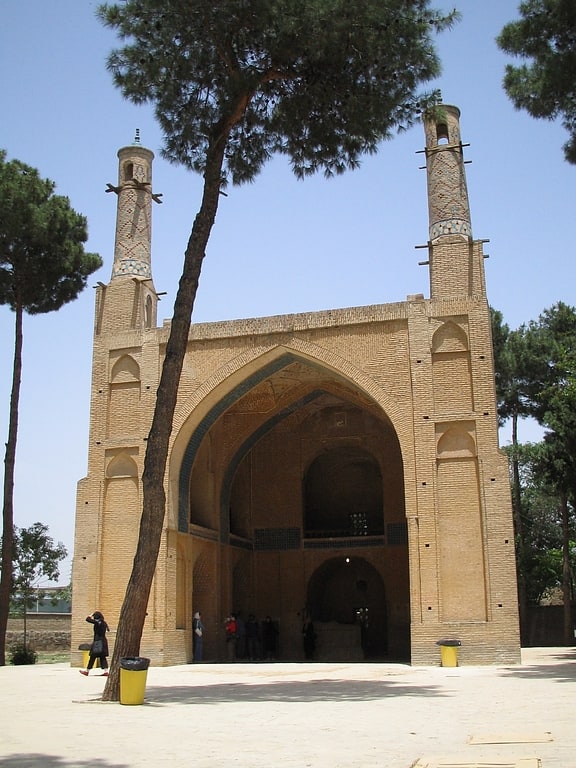
Also known as: منارجنبان
Tourist attraction in Isfahan, Iran. The Monar Jonban, is a monument located in Esfahan, in central Iran. Construction began in the 14th century Safavid or Ilkhanate dynasties of Iran to cover the grave of Sufi Amu Abdollah Soqla. Its notable feature is that if one of the minarets is shaken, the other minaret will shake as well.[14]
Address: Atashgah St., Isfahan
Contemporary Arts Museum Isfahan

Also known as: هنرهای معاصر اصفهان
Museum in Isfahan, Iran. The Museum of Contemporary Art is a contemporary art museum in Isfahan, Iran, located next to the Museum of Natural History.[15]
Address: Ostandari Street, 81464 Isfahan
Ali Gholi Agha Mosque

The Ali Gholi Agha Mosque is a mosque in Isfahan, Iran, built by Ali Gholi Agha, who also built the Ali Gholi Agha hammam.[16]
Flower Garden of Isfahan

Also known as: باغ گلهای اصفهان
The Flower garden of Isfahan was one of Iran's great green space projects, which was completed in 1990s in Isfahan. The garden serves multiple purposes. It's a recreational, cultural, educational and research center. The buildings of the garden have Iranian traditional elements.[17]
Shahrestan Bridge
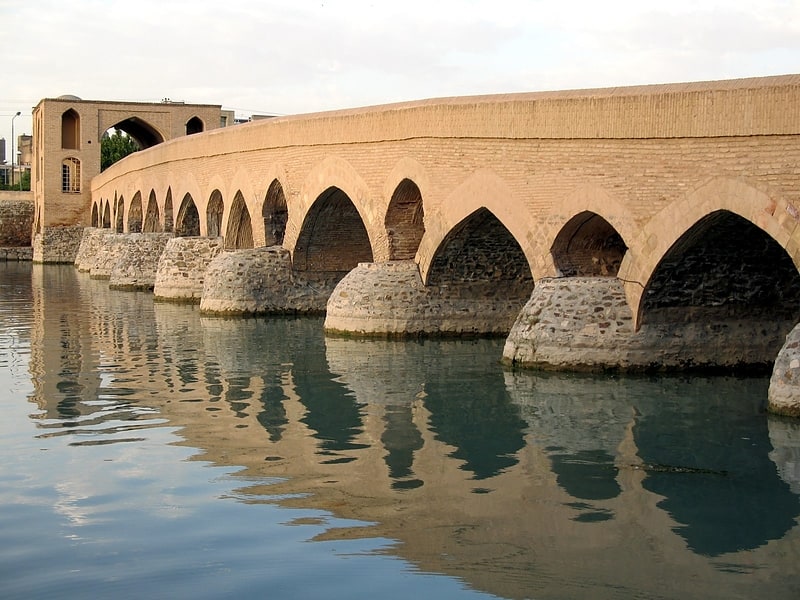
Also known as: پل شهرستان
Arch bridge in Isfahan, Iran. The Shahrestan bridge is the oldest bridge on the Zayandeh River in Iran. The foundations date back to the Sasanian era, but the top was renovated twice, first in the 10th century by the Buyids, then during the 11th century during the Seljuk period. Nevertheless, the architectural style is entirely Sassanian.
The bridge consists of two parabolas. The vertical parabola ensures that the middle of the bridge is its highest point. The horizontal parabola produces a bend to the west, strengthening it against the flow of the river. The bridge is 107.8 metres long and an average of 5.2 metres wide. It has two tiers of pointed arches, thirteen large ones spanning the river itself, and eight smaller ones that nest between them. The purpose of the latter is to quicken the flow of water during floods, taking pressure off the structure. The Zayandeh River has recently been diverted about 100 meters away from the bridge towards the south, leaving an artificial lake around the bridge to protect it from further damage.[18]
Address: 2nd Moshtagh St., Isfahan
Marnan Bridge
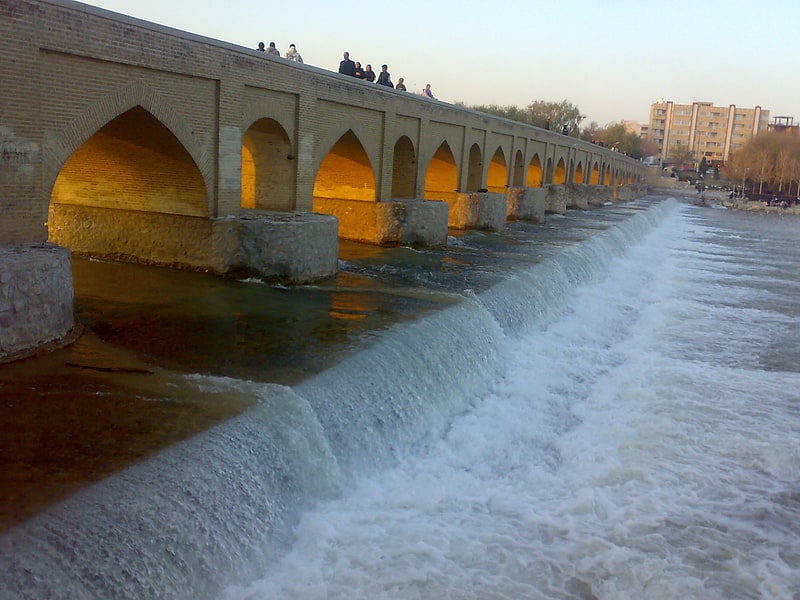
Also known as: پل مارنان
Bridge in Isfahan, Iran. Marnan Bridge is a historical bridge in Isfahan, Iran. The current structure of the bridge dates back to the Safavid era, but its foundations are older and possibly as old as the Shahrestan bridge, which dates back to the Sasanian era[19]
Address: Boustan Sadi Street, 81464 Isfahan
Seyyed mosque
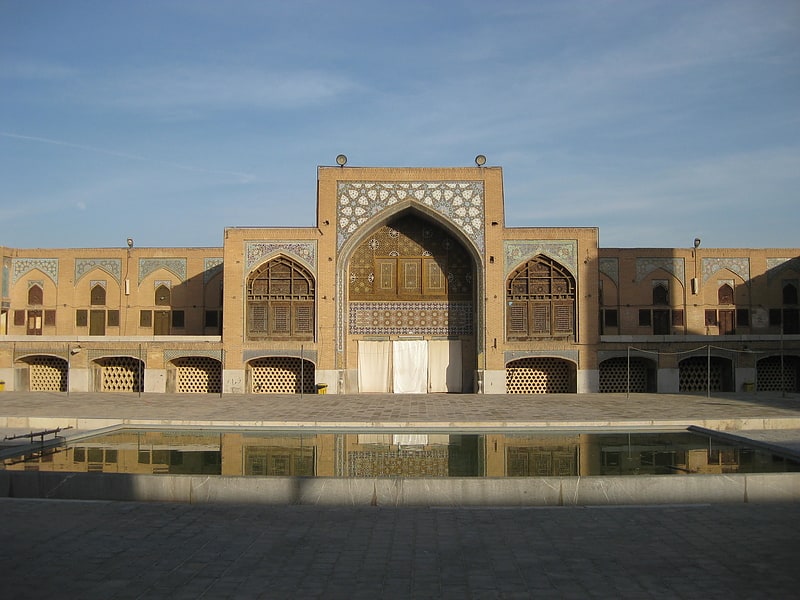
Also known as: مسجد سید
Mosque in Isfahan, Iran. Seyyed Mosque is the biggest and the most famous mosque from the Qajar era in Isfahan. It was founded by Seyyed Mohammad Bagher Shafti, one of the most famous clergymen in Isfahan. It was founded in the middle of the 19th century, but its tiling lasted until the end of the century. The seyyed mosque is the best sample for studying the tiling art in the Qajar era.[20]
Chaharbagh
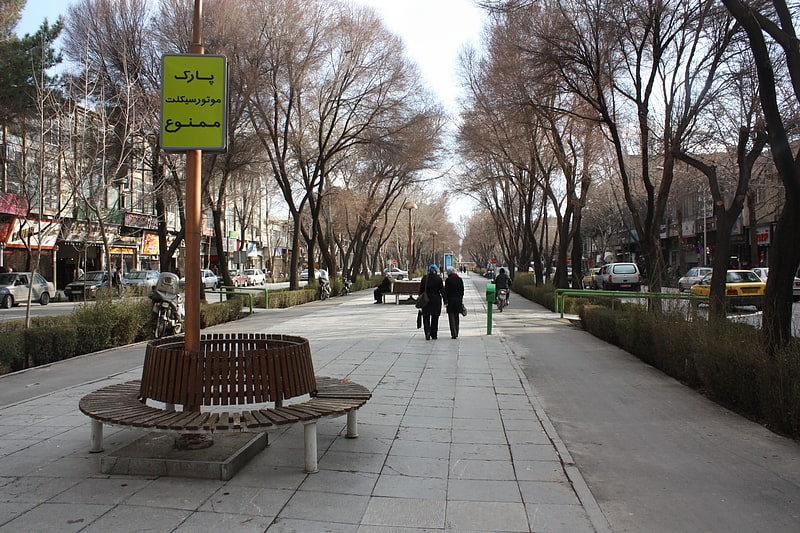
Also known as: خیابان چهارباغ اصفهان
Avenue in Isfahan, Iran. Chahar Bagh Boulevard is a historical avenue in Isfahan constructed in the Safavid era of Iran. This histories street is very similar to the Champs Elysees in paris,which some visitors called the champs Elysees of isfahan.
The avenue, historically, is the most famous in all of Persia. It connects the northern parts of the city to the southern sections and is about 6 kilometers long. On the east side of this street, there are the Hasht Behesht and Chehel Sotoun gardens.[21]
Bagh-e Rezvan Cemetery
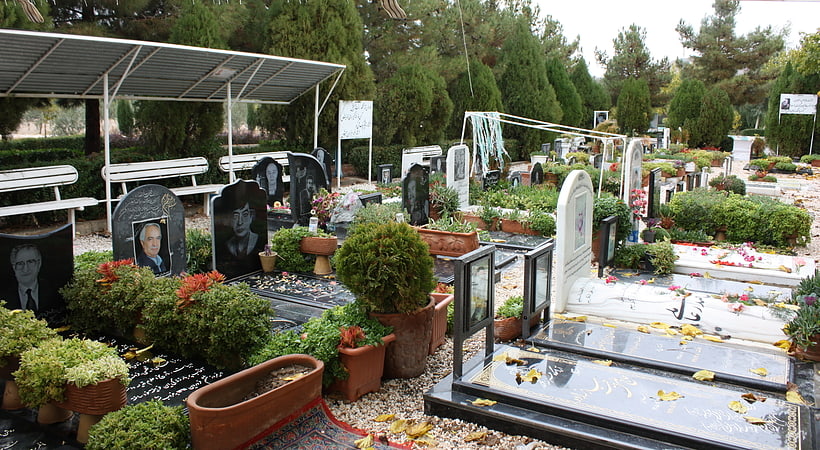
Cemetery in Isfahan, Iran. Bagh-e Rezvan Cemetery is the biggest cemetery in Isfahan.
It is at 12 kilometers east of Isfahan.[22]
Joubi Bridge
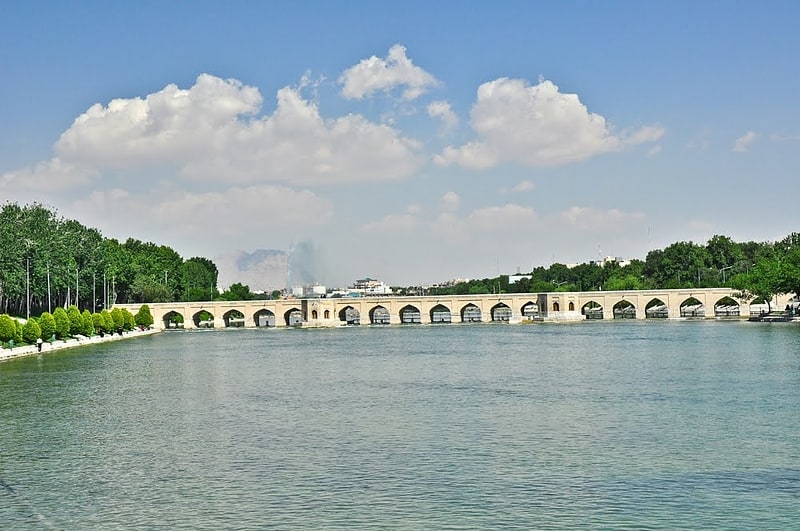
Also known as: پل جویی
Tourist attraction in Isfahan, Iran. Joubi Bridge, also called the Choobi Bridge, is a bridge in Isfahan, Iran. It was built in 1665, during the Safavid era.
The Joui Bridge is located between Khaju and Ferdowsi bridges. It is 147 meters long and 4 meters wide, with 21 arches. It was built during the reign of Shah Abbas II to irrigate and connect the king's gardens on both sides of the river. The bridge and the two parlours within were for the exclusive use of the shah and his courtiers. Nowadays the parlours are being used as tea houses.[23]
Museum of Decorative Arts
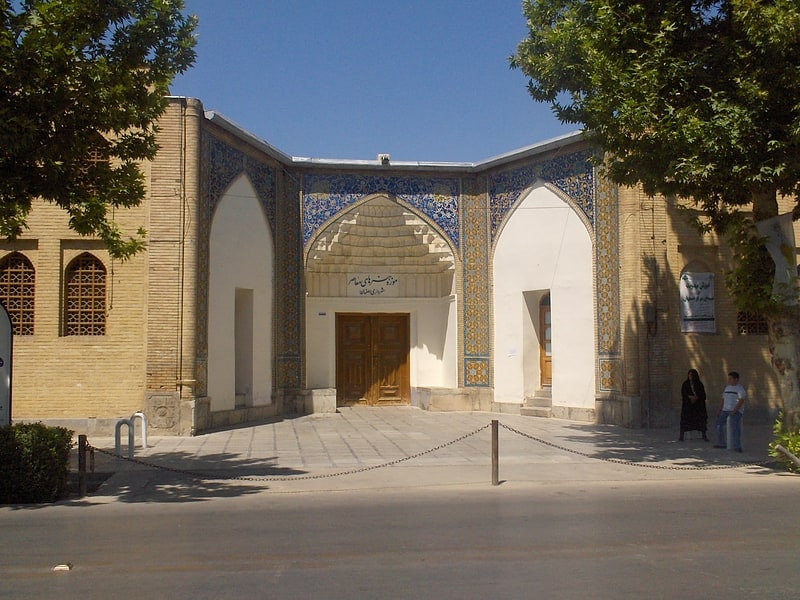
Also known as: موزه هنرهای تزئینی و معاصر اصفهان
Museum in Isfahan, Iran. The museum of decorative arts in Isfahan was founded in 1995. More than 3000 artworks from the Safavid and Qajar era are kept in the museum. The building of the museum belongs to the era of Abbas I. The building was constructed during the era of Abbas I as a part of Charbagh Palace. There is a multi-storey tower beside the museum, which belongs to the Qajar era. The tower was used at first as watchtower and then as jail. The tower does not have any kind of decorations, bit it is regarded as a notable relic of the Safavid architecture.[24]
Address: Ostandari St, 81464 Isfahan
Rahim Khan mosque

Also known as: مسجد رحیمخان
Mosque in Isfahan, Iran. Rahim Khan Mosque is a historical mosque in Isfahan, Iran. It was built in the late 19th century. This mosque has an unusual combination of styles in architectural decorations. The shabestan of this mosque is one of the biggest shabestans in Isfahan. The shabestan, portal, iwan and outer surface of the mosque's dome have been rebuilt.[25]
Ali Gholi Agha hammam

Also known as: حمام علیقلیآقا
Museum in Isfahan, Iran. The Ali Gholi Agha hammam is a historical hammam in the Bidabad district of Isfahan, Iran. The hammam was built in 1713 by Ali Gholi Agha, who was a courtier of two Safavid kings Suleiman I and Sultan Husayn. Its architectural style is Isfahani and it was built in the late Safavid era. The structure consists of one large hammam and a small hammam and also a Howz. Each of these hammams consists of a dressing room and a Garmkhaneh, so that they could be used in that time separately by men and women. At present, the structure is a museum and can be visited by tourists.
Ali Gholi Agha and his brother Khosro Agha, who built Khosro Agha hammam, were two well-known benefactors in that time.[26]
Address: Bid Abadi St, Isfahan
Bedkhem Church
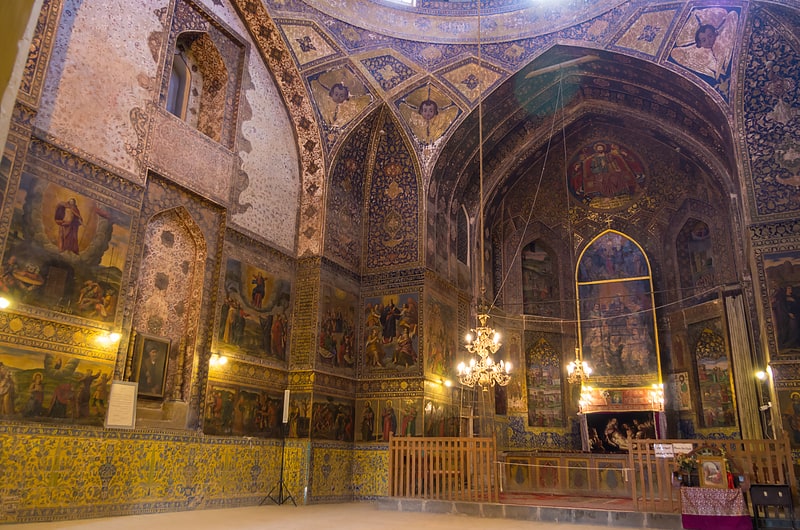
Also known as: کلیسای بیتاللحم
Armenian church in Isfahan, Iran. Holy Bethlehem Church of New Julfa or Bedkhem Church, is an Armenian Apostolic church in the Julfa quarter in Isfahan, Iran. One of the most important historical churches of the city, it belongs to the Abbas I era. The church is located in the Julfa square near Saint Mary Church. The Bedkhem church was built by an Armenian merchant named Khaje Petros. There are decorations and paintings on its walls depicting the life of Jesus. The 72 exquisite paintings, painted by Armenian artists, are presented in two rows. In the lower row the paintings are painted sequentially, but in the upper row each painting is in a separate frame.
The architecture and the gilded decorations of the church's dome are notable. Inside the church there are inscriptions in Armenian which date back to 1627 and 1711. The inscriptions are installed in remembrance of those who performed charitable work for the church.
On the southern portal there is an inscription as follows:
Pray for Khaje Petros, who was a good man, in the presence of God. He built this church by his own personal expenditure for the immortality of his name and his father's name (Vali Jan) and his mother's name (Shoushan) and his family's name in 1077 (in the Armenian calendar which is 1627 in the Gregorian calendar).The church has three parts:
- The entrance with a balcony, which seems to have been a special place for engaged girls.
- The chapel, above which is the dome.
- The apse
The church has a rectangular plan. The doors are 31 m long and 14 m high. Its dome is 26 in height. Opposite the church, there is a courtyard with two entrances.[27]
Kohneh Square
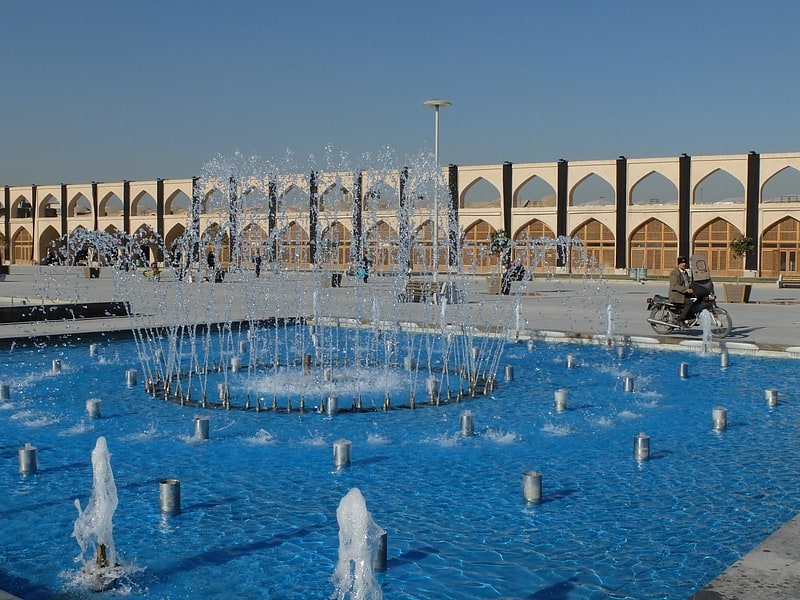
Also known as: میدان امام علی
Tourist attraction in Isfahan, Iran. Atiq Square or Atigh Square or Kohneh Square or Old Square, in Persian: was a focal point of the city of Isfahan for centuries. In the eleventh century when Isfahan was the capital of the Seljuk dynasty, it was the main square and the chief center of the business and social life of the city. It was an important central focus of the city until Naqsh-e Jahan Square was laid out in the 17th centenary. But even at that time, the Kohneh Square preserved its importance as the center of the city's minor activities. With the Jameh Mosque on the north, Qeysarieh Bazaar on the west, Harun Velayat Mausoleum and the Ali Mosque on the south, and the Seljuk palaces on the east, the Kohneh Square served as a prototype for majestic Naqsh-e Jahan Square that Shah Abbas I created in its vicinity.[28]
Ali minaret
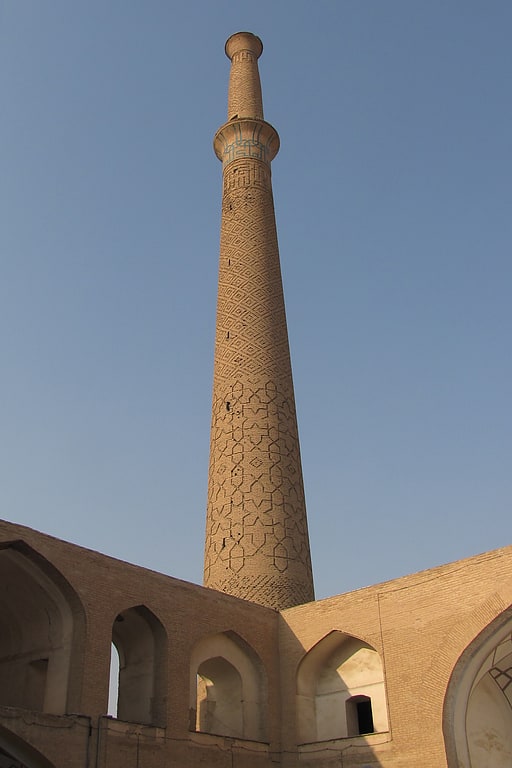
Also known as: مسجد و مناره علی
Mosque in Isfahan, Iran. Ali minaret is a historical minaret in Isfahan, Iran. It is close to the Ali mosque. This minaret is the oldest minaret in Isfahan, which dates back to the 11th century. This minaret is 52 metres in height and is the second highest historical minaret in Isfahan after the Sarban minaret. It is said that this minaret was originally 54 metres, but its height has been decreased 2 metres in the course of time. There are four inscriptions on the Ali minaret. One of the inscriptions is made of brick and the others are made of ceramic.[29]
St. Mary Church

Also known as: کلیسای مریم و هاکوپ
Church in Isfahan, Iran. Saint Mary Church of New Julfa is a historical Armenian church in Isfahan, Iran, completed in 1613.[30]
Nazhvan Forest Park
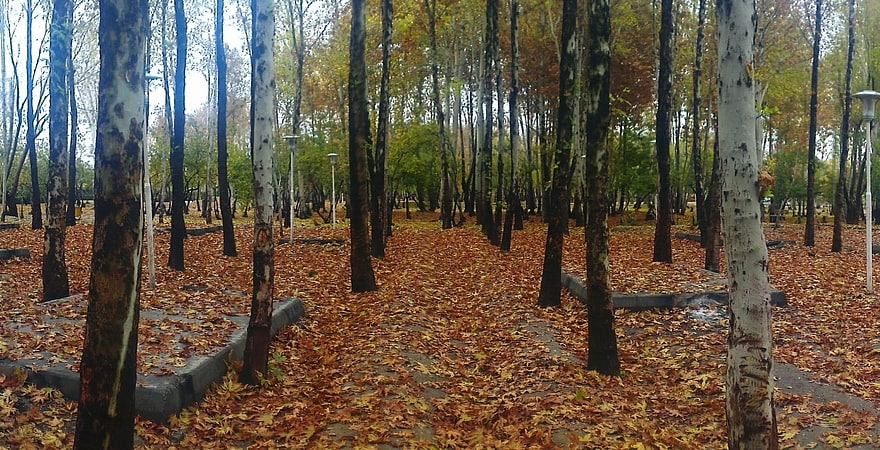
Also known as: منطقه جنگلی ناژوان
Park in Isfahan, Iran. The Nazhvan Forest Park is one of the few gardens in Isfahan, which has been rather safe from expansion and development of the city and freshens the air of Isfahan. The word nazhvan consists of two words nazh, which means "poplar" in Persian and van, which is a Persian suffix for place. Therefore nazhvan means "a place for poplars". Nazhvan has an area of 1200 ha and is located in the western part of the city. It's the only remaining part of the green space in the suburban area of Isfahan. It plays the role of Isfahan's lungs and has a special importance from the bio-environmental point of view for the city. Zayanderud river flows through the middle of the garden and this is one of the distinguished features of Nazhvan that makes it different from other parks in Isfahan. As parts of the Project for prosperity of Nazhvan, the local government of Isfahan created facilities in Nazhvan as nearby recreational area like sport grounds, a swimming pool, a campsite, playgrounds for children, also facilities for horse droshky, horse sport, boating and cycling.[31]
Hakim Mosque
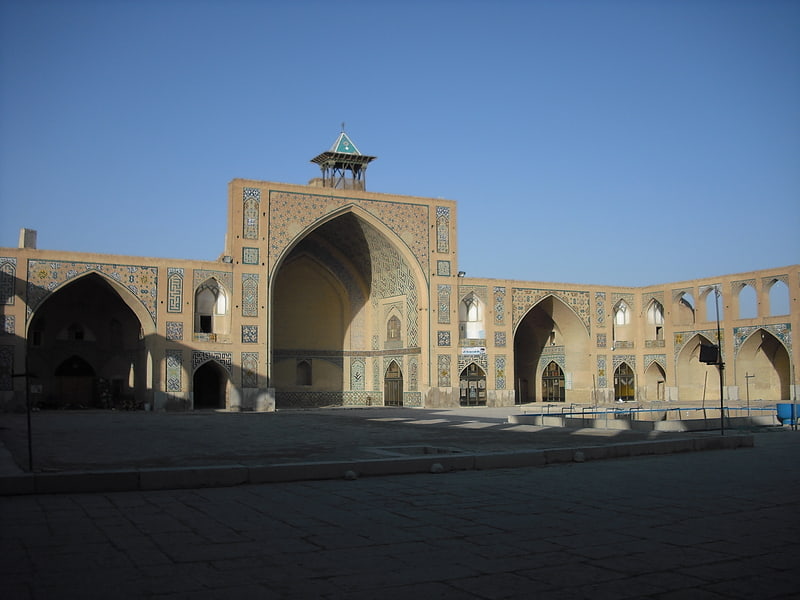
Also known as: مسجد حکیم
Mosque in Isfahan, Iran. Hakim Mosque is one of the oldest mosques in Isfahan, Iran. Completed in the mid-17th century, in the Safavid era, it is named after Moḥammad-Dāvud Khan Ḥakim who funded the construction.
The mosque was constructed between 1656 and 1663 and retained the "standard four ayvan plan and a two-storey arcade" At the same time, however, it also bore a more simple structural pattern and brick and tile surface compared to the ones that had been erected under Abbas I (r. 1588-1629).[32]
Address: Esfahan Bazaar, 81464 Isfahan
Khomeyni Shahr

City in Iran. Khomeyni Shahr is a city and capital of Khomeyni Shahr County, Isfahan Province, Iran. At the 2006 census, its population was 218,737, in 57,551 families.
Khomeyni Shahr is now part of the Isfahan Metropolitan area.
The town was originally known as Sedeh. In the 1930s, the name was changed to Homayunshahr. After the Iranian Revolution of 1979, the city was renamed again to Khomeyni Shahr (meaning "City of Khomeyni"), in honor of Ayatollah Khomeini. Locals have continued to refer to the city as Sedeh. There has been an ongoing effort to rename back the city's name to its historical one Mehrbin (مهربین).[33]
Grand Bazaar
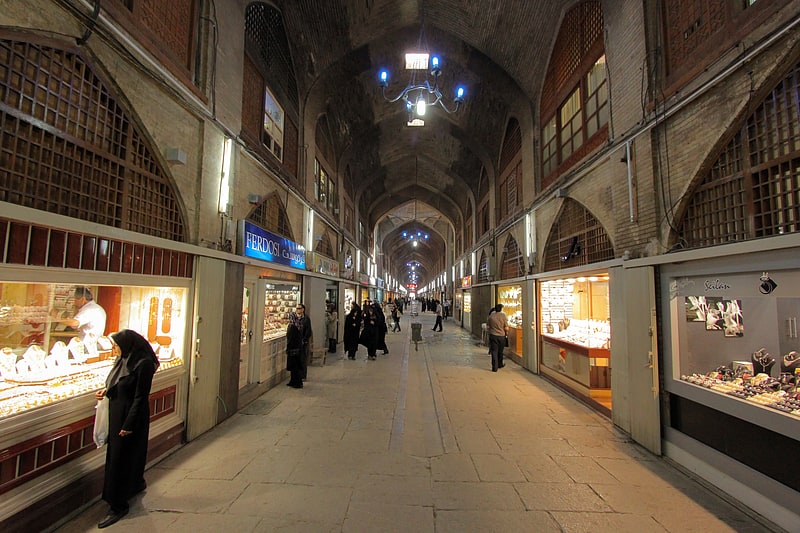
The Grand Bazaar is a historical market located in Isfahan, Iran, also known as the Qeysarriyeh Bazaar, Qeysarie bazaar or Soltani bazaar. The main commercial activities in the Qeysarie bazaar are carpet and kilim selling.
The bazaar was one of the greatest and luxurious trading center in the safavid era. It was built in 1620 on the northern side of Naqsh-e Jahan Square. It connects the Naqsh-e Jahan Square to the Kohneh Square and seljukid part of Isfahan.
The Qeysarie bazaar includes these parts:
- Orian bazaar
- Harounie
- Nimavard-e Golshan
- Makhlas
- Samavarsazha (Samovarmakers)
- Maqsudbeyk
In the Qeysarie bazaar, there are many historical buildings such as Nimavar school, Sadr school, Khayyatha mosque, No mosque, Zolfaghar mosque, Shishe mosque and Jarchi mosque. The Qeysarie gate is the main entrance of the bazaar.[34]
St. Catherine Convent
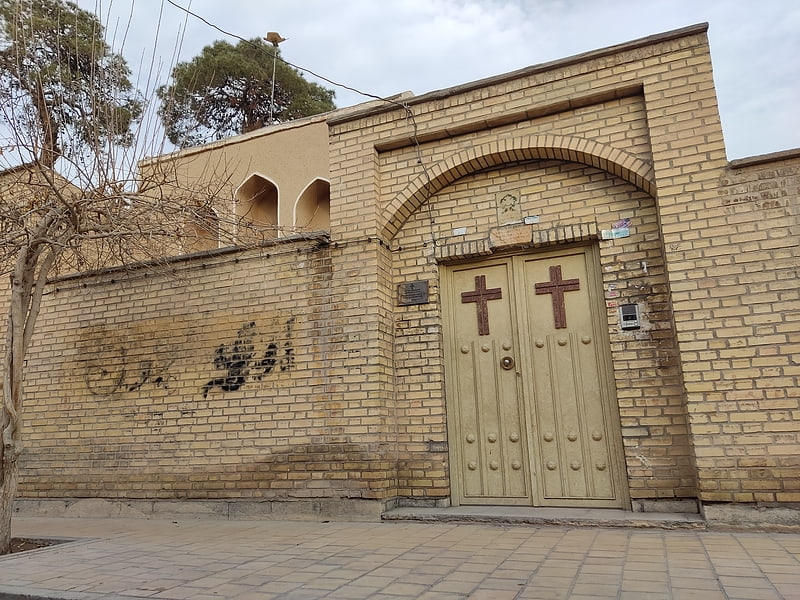
Church in Isfahan, Iran. Saint Catherine Convent of New Julfa, is an Armenian Apostolic church in New Julfa, Iran. It is located in Charsou neighbourhood of New Julfa, next to St. John the Baptist Church.[35]